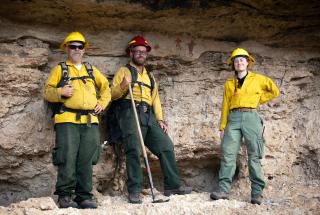Discovering past and people
Andrew Avitt Southwestern Region October 6, 2023

As Kristen Francis looks out across the quiet expanse of the Kaibab Plateau in Northern Arizona, she wonders at what all the land has seen and what we can learn if we look closely.
“We learn from the past, the different ways people lived and how they interacted with the landscape, and that tells us a lot about ourselves.”
Francis is an assistant district archaeologist with the Kaibab National Forest. Archaeologists like Francis are essential in the Forest Service to surveying the land, discovering, and protecting cultural, historic and prehistoric sites.
Large swaths of the nation’s 193 million acres of national forests have never been surveyed.
“One of our main duties, as an archaeologist, is to survey project areas before any potentially ground disturbing activity takes place, like constructing roads, forest thinning or other infrastructure projects,” said Francis.

Archaeologists are also essential when trying to build containment around and suppress wildfires.
“We assess the situation, where the fire is burning, the suppression tactics being used to determine what known archaeological sites are at risk, protecting them, but also surveying new areas, sometimes we’ll walk ahead of bulldozers to ensure that damage is not being done to unknown sites.”
Whether assisting fire personnel or conducting a survey, archaeologists like Francis are checking for artifacts on the landscape– anything older than 50 years. They then record the number and type of artifacts found, which will vary based on the region and history of the people who once traveled across or lived there.
In Northern Arizona archaeologists have recorded projectile points (arrowheads), stone tools, ancient trail markers, designs/inscriptions carved into trees, pottery, ceramics, grinding stones, rock art, and even perishable items such as baskets, textiles, and wooden tools persevered in dry alcoves and caves. They also discover a range of structures.

There are many prehistoric structures built before western recorded history. There are pueblos, pit houses, granaries, and cliff dwellings. Then there are also historic artifacts and structures, brush structures, hogan’s, sweat lodges, old logging or mining camps, cabins, and insulator trees once used to run telegraph lines.
There are many unwritten perks of the job said Francis. “I like to be outside to do fieldwork, and to discover artifacts and the stories behind those artifacts. Learning about these people who came before, how they used the land in ways to thrive, especially like here in the high desert so long ago, it’s mind blowing.”
Each artifact discovered offers a tiny glimpse, a sliver of context into the past.
“Each time we find something, it’s a clue. Then we find another. Then another and the picture starts to come together about how this one spot was used a long time ago. As an archaeologist doing a survey, we might be the first person that has seen this place since it was used a 1000 years ago. There’s something special about that.”
Francis said her interest in archaeology first became apparent in high school.

“People were confusing, and I wanted to understand people. So anthropology was a good way to expose myself to more cultures and different ways of living,” said Francis. “I had an anthropology class in high school, it was the same teacher that also taught my history class and for some reason I would fall asleep in her history class, but her anthropology class was super dope. I loved it. So I just kind of decided, I’m going to be an anthropologist.”
After that Francis studied Anthropology at Utah State University, and later would break into the industry as what industry insiders call a shovel bum.
“A shovel bum is someone who works as an archaeologist on a project-by-project basis surveying and occasionally excavating areas to ensure contractors are within federal regulations when implementing a project to avoid, minimize, or mitigate damage to potential archaeological or cultural sites.”
In the end it was a great place to get experience. Now working for the Forest Service, she said she has appreciated learning even more of the process.

“Working for the Forest Service I get to see the whole process, start to finish, planning the project, the background research and then seeing it through to the data and data entry and report writing, and consultation with Arizona’s State Historic Preservation Office and Tribes. Though I mostly enjoy the field work, I like to be outside, discovering, finding cool things, and protecting them.”
If you are interested in becoming an archaeologist or learning more about other archaeology positions, please visit the Forest Service Resource Management Careers page.
The Forest Service is recruiting for hundreds of positions throughout the agency. Applications are available through USAJOBS.
Kaibab National Forest , Archaeology, Cultural, Education, Fire, Heritage and Cultural Resources, History, Jobs, Wildfire, Wildfire Crisis , historic preservation, arizona, women, pictographs, archaeologist